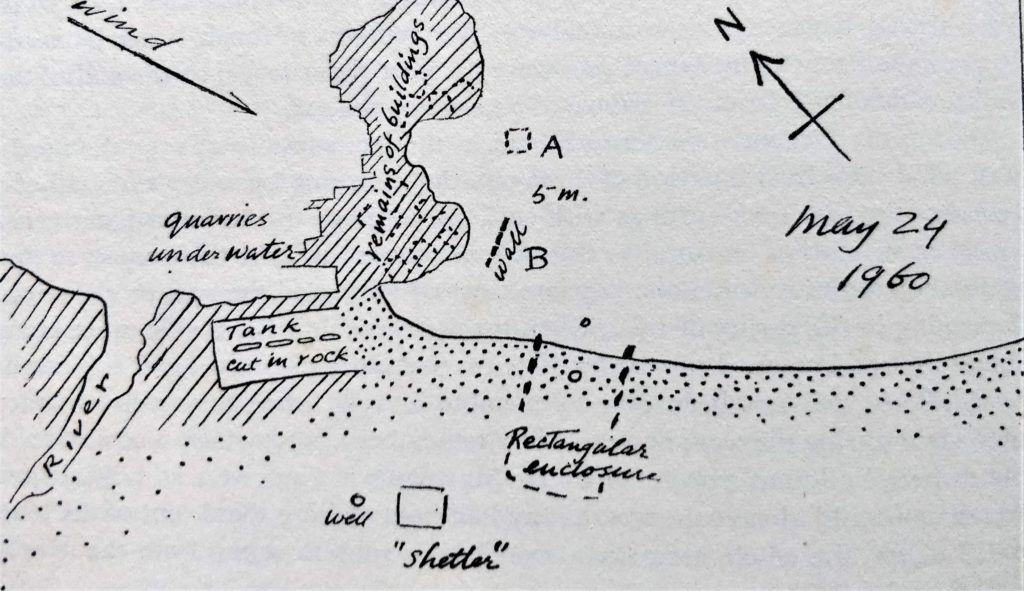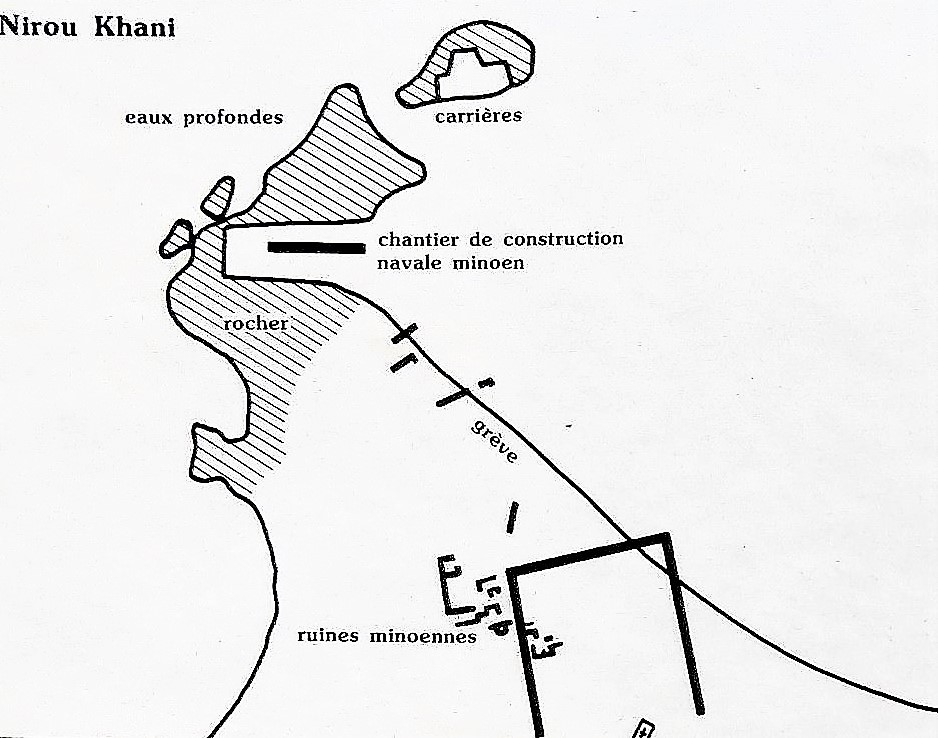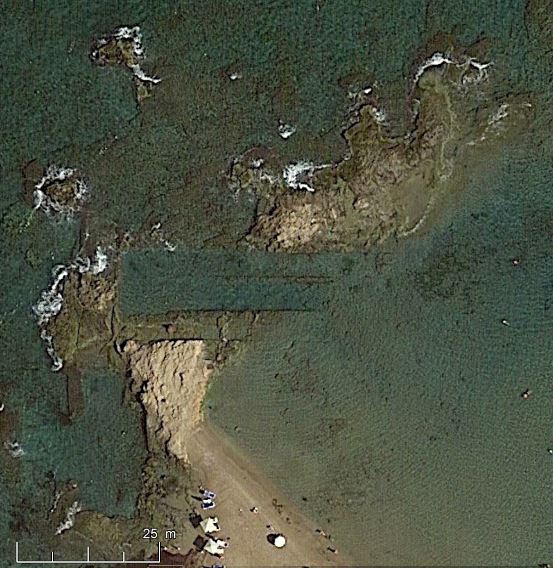Location: 35.33373N 25.24323E
This rock-cut structure has been inspected by several authors. Let’s quote them first.
Frost (1963, p 107-109):
“Evans himself, Dr Marinatos and other archaeologists recognized the remains as being part of a harbour. […]

The sketch was a personal aide mémoire, the various features were drawn relative to each other but without being measured. I have since added the buildings mentioned by Dr Marinatos.
The windward or north-westward slopes of the promontory are cut at water level and below by quarries. […]
In the report describing Dr Marinatos’ excavations of 1926 two structures, ‘a flagged shelter of poros stone containing quantities of late Minoan jars and perforated ceramic spheres’, and also a water well, were excavated in the field now covered by rubbish dump. ‘A large rectangular space with walls of big limestone blocks, one meter across’ started in the field, to the east of the well and ‘shelter’, ran across the beach and ended in the sea. The clou of the whole area was the tank-like cutting at the junction of the rocky promontory and the beach. This cutting ’40 meters wide and 42 meters long is divided into two unequal compartments by a wall; the whole is now about 1.80 meters below sea level. The use of the construction will only be explicable if it is possible to determine the degree of subsidence of the land. In any case it was either a mooring for boats or a Minoan shipyard. The port which was the first Minoan example to be discovered, must have had connections with Knossos’
I have translated this passage from the original report on Nirou Khani, but I suspect that there must have been a misprint where distances are concerned. The tank in question is nearer 10 x 12 meters than 40 x 42.”
Flemming & Pirazzoli (1981, p 74-76):
“Une structure rectangulaire taillée dans la roche a été différemment interprétée. Marinatos (1926), qui estimait la profondeur de l’eau à 1.8 m, à l’intérieur, y voyait une darse ou un chantier de construction naval. Frost (1963, p. 107-109) parle pour Nirou Khani de carrières et de ce qu’elle croit être une construction submergée. Elle en déduit pour ce site une submersion de 4-5 m. Cette interprétation implique que la ‘darse’ était à sec. Or, d’après les observations de N.C. Flemming, la submersion a été inférieure à 5 m.

Cependant le bassin ne semble avoir la forme ni d’une darse, ni d’une cale, ni même d’un chantier de construction. D’autre part, la submersion des carrières et des murs minoens à l’est du bassin indique une montée du niveau de la mer d’au moins 1.75 m. Cette submersion apparait insuffisante pour inonder la structure rectangulaire, qui était donc à sec lors de son utilisation.”
In the same article Flemming & Pirazzoli estimate the relative sea level rise between 1.2 and 2 m at Nirou Khani, indicating that the structure bottom was close to the seawater level in ancient times.
Blackman (2013, p 12):
“A promising parallel for the Minoan ‘shipsheds’ at Kommos has recently been discovered on the north coast of Crete at Poros/Katsamba (Herakleion) […]. We thus have a plausible parallel for Minoan ‘storage shipsheds’, but Minoan parallels for the later ‘covered slipways’ have not been found, unless one accepts some remains on the shore at Gournia. The rock-cut basin at Nirou Khani has been suggested as a parallel.”
However, Blackman does not mention the Nirou Khani structure any more in his book.
Theodoulou (2023, p 145):
“The most striking, though enigmatic, finding of Marinatos’ work concerns the large rectangular cuttings at the base of the rocky cape. Its length is 47.4 m, and its width is 10 m. It is divided longitudinally with stonework, in two uneven zones, 4.95 m wide at the south and 4.25 m in the north. Marinatos, considering that the bottom of the cutting was below the sea level, by about 1.80-2.00 m, considered that the brush was on dry land during the Minoan times, arguing its possible use as a shipshed. Recent underwater research shows that the northern compartment of the cutting is closed off and could not have been used for keeping a ship in, except perhaps for the storage of its equipment. However, the 47.4 x 4.95 m open south-eastern compartment is considered to be more suitable for the construction, repair or guarding of two or more ships. Confirming its use, however, requires an investigation.”
What can we add in order to clarify this matter?

On the day this picture was taken, the sea was calm (no Meltem blowing). The dimensions of the rock-cut basin are visible:
- Width: around 10 m, with a separating wall
- Length: up to around 47.5 m
To the south of both basins, a slightly higher area looks like a quarried area.
A slope cannot be seen on the picture and the various visitors did not mention anything about a slope as the bottom of the basin is probably horizontal.
The Nirou Khani rock-cut basin is therefore not a port, as it is too small, but the size of the southern basin corresponds very well to a slipway. However, if it had no slope, it must have been difficult to haul a ship inside or to keep the workers feet dry.
In any case, the large sheltered area on the south-eastern side of the rock-cut basin may have been a safe harbour.
References
BLACKMAN, D. & RANKOV, B. et al. (2013) “Shipsheds of the Ancient Mediterranean”, Cambridge University Press, (617 p).
FLEMMING, N. & PIRAZZOLI, P. (1981) “Archéologie des côtes de la Crète”, Dossiers d’Archéologie N° 50, (p 66-81).
FROST, H. (1963) “Under the Mediterranean, Marine antiquities”, Routledge and Kegan Paul Ltd, London, (278 p).
SAUVAGE, C. (2012) “Routes maritimes et systèmes d’échanges internationaux au Bronze récent en Méditerranée orientale”, MOM Éditions, N° 61, (371 p).
THEODOULOU, T., (2023), “Coasting, Natural anchorages and coastal settlements of the Bronze Age on the northern central coastline of Crete”, Ephorate of Antiquities of Herakleion, (191 p).